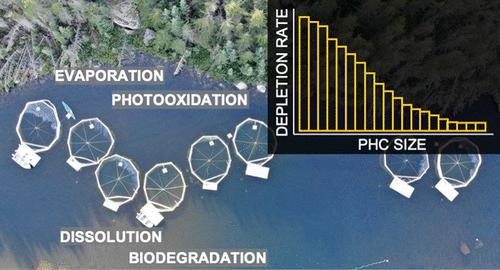当前位置:
X-MOL 学术
›
Environ. Sci. Technol.
›
论文详情
Our official English website, www.x-mol.net, welcomes your feedback! (Note: you will need to create a separate account there.)
Chemical Weathering Patterns of Diluted Bitumen Spilled into Freshwater Limnocorrals
Environmental Science & Technology ( IF 11.4 ) Pub Date : 2023-06-02 , DOI: 10.1021/acs.est.2c05468 Sawyer S Stoyanovich , Leslie J Saunders , Zeyu Yang 1 , Mark L Hanson 2 , Bruce P Hollebone 1 , Diane M Orihel 3 , Vince Palace 4 , Jose L Rodriguez-Gil 2, 4 , Fatemeh S Mirnaghi 1 , Keval Shah 1 , Jules M Blais
Environmental Science & Technology ( IF 11.4 ) Pub Date : 2023-06-02 , DOI: 10.1021/acs.est.2c05468 Sawyer S Stoyanovich , Leslie J Saunders , Zeyu Yang 1 , Mark L Hanson 2 , Bruce P Hollebone 1 , Diane M Orihel 3 , Vince Palace 4 , Jose L Rodriguez-Gil 2, 4 , Fatemeh S Mirnaghi 1 , Keval Shah 1 , Jules M Blais
Affiliation

|
Due to the sudden nature of oil spills, few controlled studies have documented how oil weathers immediately following accidental release into a natural lake environment. Here, we evaluated the weathering patterns of Cold Lake Winter Blend, a diluted bitumen (dilbit) product, by performing a series of controlled spills into limnocorrals installed in a freshwater lake in Northern Ontario, Canada. Using a regression-based design, we added seven different dilbit volumes, ranging from 1.5 to 180 L, resulting in oil-to-water ratios between 1:71,000 (v/v) and 1:500 (v/v). We monitored changes in the composition of various petroleum hydrocarbons (PHCs), including n-alkanes, polycyclic aromatic hydrocarbons (PAHs), and oil biomarkers in dilbit over time, as it naturally weathered for 70 days. Depletion rate constants (kD) of n-alkanes and PAHs ranged from 0.0009 to 0.41 d–1 and 0.0008 to 0.38 d–1, respectively. There was no significant relationship between kD and spill volume, suggesting that spill size did not influence the depletion of petroleum hydrocarbons from the slick. Diagnostic ratios calculated from concentrations of n-alkanes, isoprenoids, and PAHs indicated that evaporation and photooxidation were major processes contributing to dilbit weathering, whereas dissolution and biodegradation were less important. These results demonstrate the usefulness of large scale field studies carried out under realistic environmental conditions to elucidate the role of different weathering processes following a dilbit spill.
中文翻译:

稀释沥青泄漏到淡水湖沼珊瑚中的化学风化模式
由于石油泄漏的突发性,很少有对照研究记录石油在意外释放到自然湖泊环境后如何立即风化。在这里,我们通过对安装在加拿大安大略省北部淡水湖中的湖沼进行一系列受控泄漏,评估了冷湖冬季混合物(一种稀释沥青(dilbit)产品)的风化模式。使用基于回归的设计,我们添加了 7 种不同的稀释沥青体积,范围从 1.5 升到 180 升,导致油水比在 1:71,000 (v/v) 和 1:500 (v/v) 之间。我们监测了稀释沥青中各种石油烃 (PHC) 的成分随时间的变化,包括正构烷烃、多环芳烃 (PAH) 和石油生物标志物,因为它自然风化了 70 天。消耗率常数(正构烷烃和多环芳烃的k D )范围分别为 0.0009 至 0.41 d –1和 0.0008 至 0.38 d –1。k D和溢油量之间没有显着关系,这表明溢油量不会影响浮油中石油烃的消耗。根据n浓度计算的诊断率烷烃、类异戊二烯和多环芳烃表明,蒸发和光氧化是导致稀释沥青风化的主要过程,而溶解和生物降解则不太重要。这些结果证明了在现实环境条件下进行的大规模现场研究的有用性,以阐明稀释沥青泄漏后不同风化过程的作用。
更新日期:2023-06-02
中文翻译:

稀释沥青泄漏到淡水湖沼珊瑚中的化学风化模式
由于石油泄漏的突发性,很少有对照研究记录石油在意外释放到自然湖泊环境后如何立即风化。在这里,我们通过对安装在加拿大安大略省北部淡水湖中的湖沼进行一系列受控泄漏,评估了冷湖冬季混合物(一种稀释沥青(dilbit)产品)的风化模式。使用基于回归的设计,我们添加了 7 种不同的稀释沥青体积,范围从 1.5 升到 180 升,导致油水比在 1:71,000 (v/v) 和 1:500 (v/v) 之间。我们监测了稀释沥青中各种石油烃 (PHC) 的成分随时间的变化,包括正构烷烃、多环芳烃 (PAH) 和石油生物标志物,因为它自然风化了 70 天。消耗率常数(正构烷烃和多环芳烃的k D )范围分别为 0.0009 至 0.41 d –1和 0.0008 至 0.38 d –1。k D和溢油量之间没有显着关系,这表明溢油量不会影响浮油中石油烃的消耗。根据n浓度计算的诊断率烷烃、类异戊二烯和多环芳烃表明,蒸发和光氧化是导致稀释沥青风化的主要过程,而溶解和生物降解则不太重要。这些结果证明了在现实环境条件下进行的大规模现场研究的有用性,以阐明稀释沥青泄漏后不同风化过程的作用。


























 京公网安备 11010802027423号
京公网安备 11010802027423号